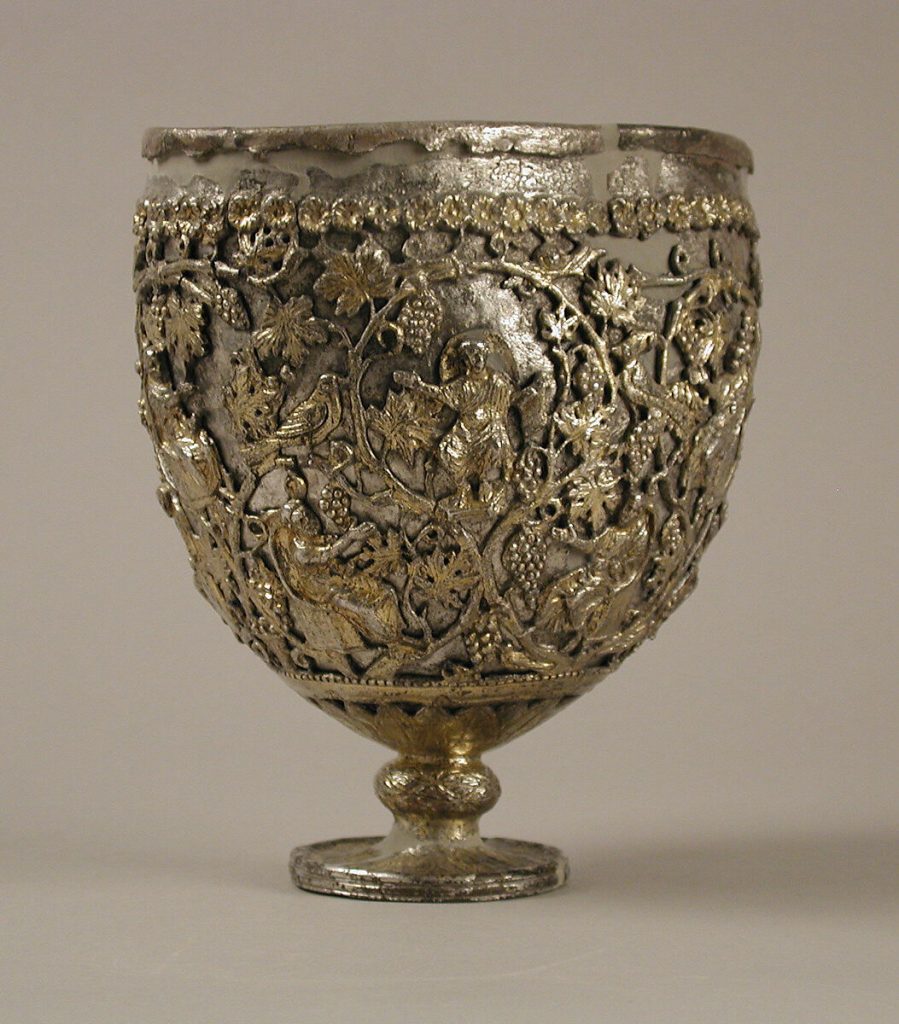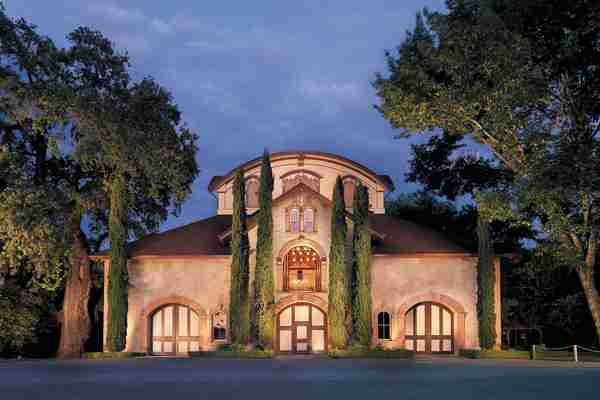The History Of Wine Glasses (the CliffsNotes version)
I felt that based on the size of my stemware collection I’m qualified to teach a class on the history of wine glasses. I own an absurd number of wine glasses. How many is absurd? North of 200, let’s just leave it at that.
By any reasonable standard, I meet the clinical definition of a hoarding when it comes to my stemware — an excessive collection of items, along with the inability to discard them.
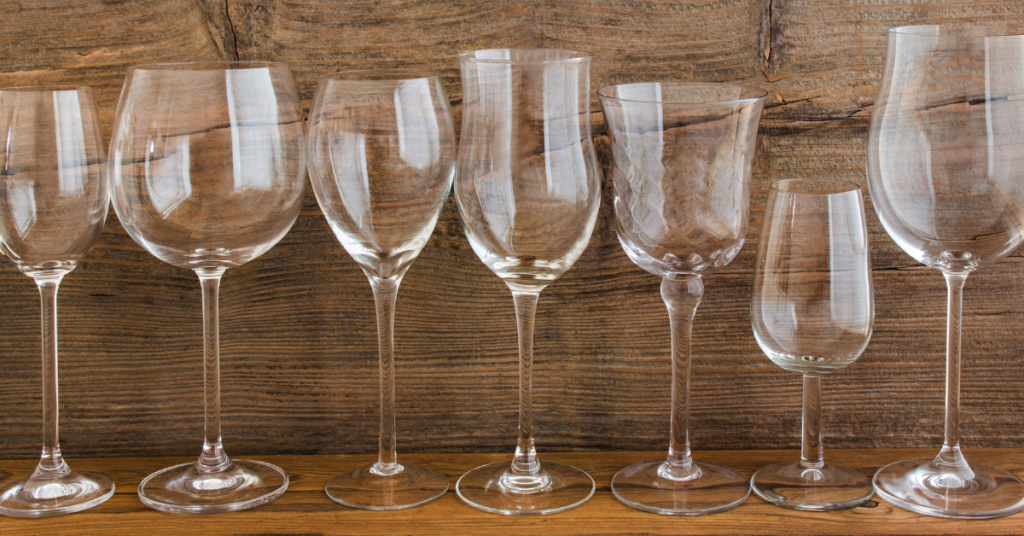
When Were Wine Glasses Invented?
Every once in a while, I attempt a stemware purge, and while I might get rid of half a dozen glasses, I always end up replacing them with more.
The thing I love most about my wine glass hoard is that so much of it is reflective of history, both personal and societal.
Wine glasses have changed a great deal over time — in size, shape, color and style.
According to a study published in the British Medical Journal, between 1700 and 2017, the size of the average wine glass increased nearly seven times, with the sharpest increase in size coming in the last few decades.
In the 1700s, the average wine glass held about 2.2 ounces of wine. Today, the average wine glass holds about 15.2 ounces.
The standard pour (or serving) of wine is 6 ounces, so today’s glasses hold more than two servings each.
So, how did we get from 2.2 ounces to 15.2 ounces?
While glass occurs naturally (think volcanic obsidian), glass making dates back to the ancient civilizations of Syria, Egypt, and Mesopotamia.
Glass wine vessels first appeared in Egypt sometime around 1500 BC, but it wasn’t until the Romans discovered the technique of glass blowing that glass became both functional and highly sought after.
With the advent of glass blowing, craftsmen were able to create shapes in a much faster amount of time, and at a much lower cost.

The Romans almost always mixed their wine with water — drinking undiluted wine was considered barbaric. Mixing was done in the glass, so most Roman drinking vessels were rather simple, and stemless, like this one, dating from the 3rd century AD.
However, some examples of Roman glasses were highly intricate, like the Lycurgus Cup (below), which must have been a real bear to wash.
The cup is unusual because it looks jade green when lit from the front, but red when lit from behind.
How did the Romans pull this off? Science. They added tiny (like one thousandth the size of a grain of table salt) particles of silver and gold to the molten glass, and the result was, well, pretty damn impressive.
After the fall of the Roman Empire, there was a decline in glass production In Europe, and drinking vessels were often made of silver, and often highly intricate.
Drinking wine out of a silver cup makes the wine taste like aluminum foil, so it wasn’t long before glass drinking cups were back in style and demand.
Beginning in the 10th century, there was a resurgence in European glass, beginning with the stained-glass window, which featured heavily in Romanesque and Gothic architecture.
With this resurgence, glassmaking hubs were established on the island of Murano in Venice, and in Bohemia, in the modern day Czech Republic.
Venice became the center of European glassware production from the Middle Ages through the Renaissance, reaching the peak of its popularity in the 15th and 16th centuries.
Glass production in Venice was so lucrative, the government passed a somewhat sketchy law in 1291, requiring all furnaces used for glassmaking be moved from Venice to the island of Murano. The stated intent was to remove the threat of a potentially disastrous fire from spreading throughout Venice. Most historians believe, however, that the real motivation behind the law was to effectually confine the glass craftsmen to the island so they couldn’t disclose trade secrets. Craftsmen weren’t allowed to leave the island without permission from the government — doing so was punishable by death.
The Venetians played glass hardball.
Murano glass makers perfected a glassmaking technique called cristallo, which produced completely clear, colorless glass. It was done by using quartz pebbles rather than ordinary sand, which has all kinds of impurities.
Over in Bohemia . . . the golden age for Bohemian glass came in the 17th century, when Bohemian glassmakers were the leading force behind Baroque styled glassware.
Early in the 17th century, a timber shortage in England led to the introduction of coal-fired furnaces, which burned significantly hotter than timber, making it possible to produce stronger glass, and represented a significant turning point in the production of European glass.
In 1675, as Englishman George Ravenscroft searched for a way to recreate Venetian cristallo, he discovered (historians disagree whether it was an accident, or a technique he learned in Venice) how to make lead crystal. What he did was to use flint as the source of silica and then added lead oxide to soften the glass and prevent crizzling (thousands of tiny surface cracks). Ravencroft’s discovery paved the way for the evolution of the today’s wine glass.

Is Lead Crystal Dangerous?
The general consensus is . . . probably not. The key is time.
Lead will leach into wine or spirits over time, so while you shouldn’t store wine or spirits in lead crystal, you can (probably) safely use lead crystal for a meal.
Ravenscroft’s patent expired in 1681, and within 15 years, over 30% of the factories in England were making leaded crystal.
During the Georgian period (1714-1830), the fashion was for fancy people to drink wine from a glass that was brought to them (glasses weren’t on the table) by a footman.
They took a sip (which was about all the glass held), and then the glass was taken back to the sidebar and refilled. Repeat. Totally impractical, but I guess it gave the footmen job security.
The English baluster glass was one of the earliest and most popular types of Georgian drinking glass.
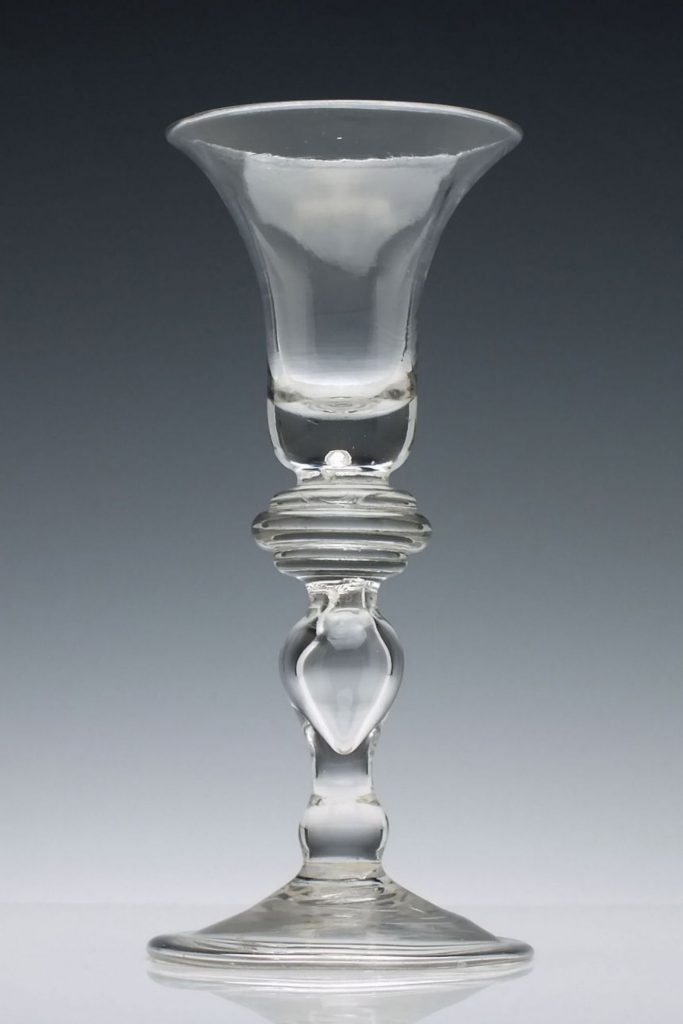
Another popular type of Georgian drinking glass was the firing glass. It had a short stem and a thick foot.
The custom at social occasions was for everyone to throw back their glass of Madeira and then bang their glasses loudly on the table, which made a noise resembling a volley of gunfire.
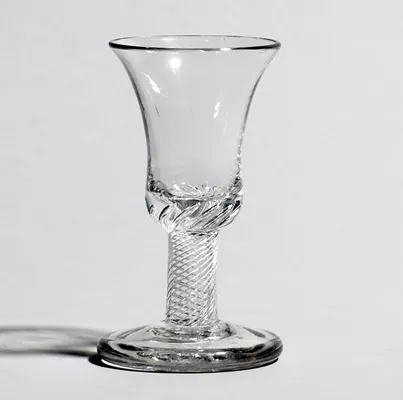
Beginning in 1745, Britain imposed a tax on glass based on weight.
The result was that glassmakers began to produce lightweight “excise” glasses, featuring hollowed out stems decorated with intricate engraving.
Jacobite glasses were a particularly beautiful, and not especially subtle, foray into politics.
Wine glasses were decorated with the Stuart rose and buds, symbols of the Jacobites, who supported the restoration of James II’s Scottish descendants, James III and Charles (aka Bonnie Prince Charlie) to the English throne.
Showing support for the House of Stuart was a not only dangerous, but a treasonous offense. Bottoms up!
The Victorian Era (1837-1901) in England was a time of exciting discoveries, inventions and exploration, following the Industrial Revolution.
At home (if you were wealthy), the size and number of wine glasses at a meal began to increase.
Dining was now a series of successive courses of plated foods, which were brought to, and placed in front of diners (footmen still had job security).
Glasses stayed on the table, so they needed to be bigger so they didn’t have to be refilled after every sip.

The Arts & Crafts movement began in the middle of the 19th century, as a reaction against industrialization of the Victorian Era.
Arts and Crafts designers believed industrialization had all but ruined artisan craftsmanship, and sought to reintroduce the art of making things by hand.
The tear glass (below) by Arts & Crafts designer, Henry Powell, is said to have been inspired by the glass vase in the foreground of the central panel of Dutch painter Hugo van der Goes work, The Portinari Triptych (1476-79). Inspiration takes all forms, I guess.

History Of Art Nouveau Wine Glasses
The Art Nouveau movement (1880-1910) was all about natural forms, curved lines, a sense of fluidity, and asymmetry. Think Tiffamy lamps.
Although Tiffany designed more than just lamps. Tiffany’s Favrile glasses were individually blown pieces of art — out of reach for for most Americans.
Carnival Glass, named because it was literally given away at carnivals, is sometimes called the “poor man’s Tiffany,” because it resembled Tiffany Favrile glass, but was decidedly affordable.
The manufacturing process for carnival glass was significantly cheaper — it was made by pouring molten glass into a mold, pressing it, and then spraying it with iridescent solution while it was still hot.
Art Deco movement of the 1920s was characterized by abstract patterns, geometric motifs and the use of man made materials. French designer, Renee Lalique (he was born in the Champagne region of France, btw), got his start in the Art Nouveau movement as a jewelry designer.
He gradually shifted to glass, and the mass production of innovative, usable art glass. Lalique’s work became highly desirable, and earned him a reputation as one of the most celebrated glassmakers in the world.
Depression Glass in the United States was the result of a major pivot in glass companies during the Great Depression.
The average family income dropped by roughly 40%, which left very little money for anything besides necessities.
Glass companies couldn’t afford to continue making labor intensive cut glass crystal, so they switched to making significantly cheaper, molded glassware.
One of my most treasured possessions is a set of Fostoria Depression glasses that belonged to my grandmother.
They are completely wrong for any kind of serious wine drinking, but I love them.
And I will never, ever part with them.
History Of Uranium Wine Glasses
Uranium, or Vaseline glass, is a particular type of glass that dates to the 1880s. It gets its neon green color from radioactive uranium, which causes it to glow under a black light.
By the 1940s, uranium was deemed critical to the war effort (think: Manhattan Project), which removed uranium from civilian use until 1958.
It probably won’t kill you.
Is Uranium Glass Dangerous?
No more so than your lead crystal.
The Nuclear Regulatory Commission did a study in 2001, and found that the amount of radiation exposure caused by uranium/Vaseline glass is only about 1% of the radiation that an average person is exposed to each year.
At the end of the day, it’s probably not going to kill you. Probably.
The 1950s saw the rise of Scandinavian Modern as the most influential design movement of the 20th century.
1950s stemware was widely influenced by Scandinavian design, with the idea that beautiful and functional everyday objects should be affordable for everyone, not just the wealthy.
Design emphasized simplicity, minimalism, and functionality. It dominated the international scene in the 1950s, and continues to shape the way we live today. Hello, IKEA.
Orrefors stemware was particularly popular in the 1950s and 60s.
This is part of my mom’s Rosenthal Variation stemware set. She received it as a wedding gift in 1965.
I love these just as much as my grandmother’s Depression glasses. In fact, I wish I’d chosen this pattern as my wedding crystal.
They’re much prettier than mine. No way I could ever part with these.
Wine glasses from the 1970s were predictably ugly (well of course they’re harvest gold, they match your Tupperware).
And then came the Paris Goblet, which was de rigueur for fashionable drinking in the 1980s.
It was heavy, and had thick walls — it’s basically a fish bowl on a stem. But everyone looked cool drinking out of them during America’s “I”ll have a Chardonnay” phase.
Then there were the heavily cut patterned glasses of the 1990s. This is my wedding crystal — Lady Anne by Gorham.
Don’t tell my husband, but I don’t even like them anymore. They’re waaaay too fussy. We’ve been married 28 years, and I’m not sure I’ve used them 28 times.
We should have registered for power tools at Home Depot. But who gets rid of their wedding crystal just because they don’t use it?
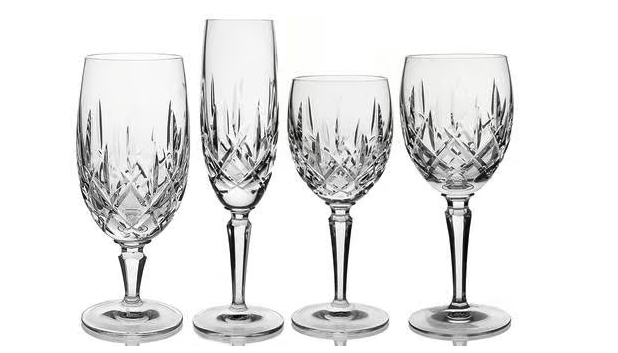
Wine is all about aroma and taste, and the shape of a wine glass can and does enhance a wine’s aroma, which in turn impacts how a wine tastes.
Dedicated wine glasses curve inward at the top, which helps concentrate aromas. By early 2000, there were dozens of companies selling complete lines of stemware for every imaginable grape variety and style of wine.
I have Riedels, Zwiesels, Eisch, Spiegelau, and a couple of culty Zaltos. And I love that you can buy them on Amazon now!
Today, you can get your hands on any size, shape, color and style wine glass your heart desires. Which is really bad news for my hoard.
You know, now that I think about it . . . I don’t own any uranium glasses.
Riedel VINUM
This Kit combines two of your favorite Riedel Wine Glasses at a discounted price. Pay for 6 glasses and get 8.
The Cabernet glass is perfect for full-bodied, complex red wines that are high in tannin. The generous size of this glass allows the bouquet to develop fully, and smooths out the rough edges. It emphasises the fruit, playing down the bitter qualities of the tannin, and allows wines to achieve balance. This pack contains two glasses. Machine-made and dishwasher safe.
The New World Pinot Noir is perfect to support the balance of fragility and fresh compact fruit in light-bodied wines from the New World. Created during several workshops with producers from Oregon, US, the tulip shape and slightly flared lip highlights the irresistible sweetness, while perfectly balancing the acidity and de-emphasizing the alcohol, to create a perfect picture of the wine. This glass is also well suited for showing the aromatics of Rosé Champagne. This pack contains 8 glasses. Machine-made and dishwasher safe (they say. I always hand wash).
“O” Cabernet & Merlot Red Wine Stemless Set
Lead-free crystal (if you’re into that sort of thing) 21.1 oz, 4.9” high, made in Austria
Cleaning & Care: Hand washing Recommended. (I was all of my Riedel glasses by hand even the “unbreakable” ones.
Specifications: 8 Red Wine Glasses.
Zwiesel Glas Tritan Modo Collection
Sounds like Zwiesel.
Since 1872, we have been dedicated to serving the world’s guests and finest hosts. Zwiesel has never just been about glass, but has always echoed the possibilities inherent in glass.
They create unique products at the highest level of manufacturing, skill, and craftsmanship.
The sound of a toast with a ZWIESEL glass is the unmistakable sound of authentic hospitality.
Eisch Sky Bordeaux Sensis
The Eisch family of Frauenau, Germany has been instrumental in the art glass movement in Germany for over 300 years. In 1952, they opened their first factory for the production of crystal stemware, barware, decanters and accessory pieces and has since become one of Germany’s leading crystal manufacturers.
Contemporary, light and elegant design; the Eisch Sensis Plus Sky Collection is designed to take the guess work out of which glass. The shape of the glass allows air to pass across the surface of the wine on the way to the nose and palate.
The proprietary SensisPlus manufacturing process is an added step the glass goes through after manufacturing. Within minutes of simply pouring wine into a SensisPlus crystal glass, it allows the complexity and potential of the wine to show to its full advantage, revealing the wine’s characteristics and hidden layers to the nose and palate.
This is achieved in the glass without touching, agitating or swirling. This not only works with wine, but in the SensisPlus barware with all types of spirits, as well. It even works with coffee and tea! There are no sprays or coatings to wear off.
No odd shaped glasses with far reaching claims needed. The crystal is dishwasher safe and the technology lasts forever.
Made in Germany. Experience SensisPlus by conducting a comparative test. Compare the SensisPlus glass with your best quality non-SensisPlus glass in similar size and shape. Pour the same amount of wine from a freshly opened bottle of wine into each of the glasses. Do not touch, agitate, or swirl the wine in either glass.
After a few minutes, check the bouquet and taste of the wine in the standard glass and then do the same with the wine in the SensisPlus glass. Experience the best of your wine without the time.
Spiegelau Definition Burgundy Wine Glasses
All Spiegelau glasses are made of lead-free crystal for superior glassware that does your wine justice. The highest quality crystal ingredients make Spiegelau products more durable, dishwasher safe, break-resistant, and more brilliant than standard wine glasses. Make each sip count with professional-quality crystal glassware.
Spiegelau’s Definition Collection aims to solve the age old quest for a wine glass that enhances your wine, yet remains classic and subtle.
Each glass in the collection is designed for a specific vintage and has the finest, thinnest walls so that each sip appears to materialize out of thin air. Experience your wine in it’s purest form from a high-quality vessel.
Josephine No. 3 designed by Kurt Josef Zalto
With this glass, the great full-bodied wines from Burgundy to Bordeaux can unfold their full potential.
Not only do its voluptuous curves visually compliment the voluminous body of great wines, both red and white, its pointed conical base also ensures that the complex play of colors may underline the full-bodied depth of the content.
History Of Wine Glasses FAQ
Where did the shape of wine glasses come from?
The idea of using it to make wine vessels dates as far back as ancient Egypt and Mesopotamia. By 1500 BCE, people used vessels with a slightly curved, flat bottom and flared rim, almost like a cereal bowl, to drink wine.
When did wine glasses come out?
As mentioned above, glass wine vessels first appeared in Egypt sometime around 1500 BC, but it wasn’t until the Romans discovered the technique of glass blowing that glass became both functional and highly sought after.
Who made the first wine glasses?
While it was the Romans who discovered the technique of glass blowing, Venice became the center of European glassware production from the Middle Ages through the Renaissance, reaching the peak of its popularity in the 15th and 16th centuries.
Why do wine glasses have stems?
Beginning in 1745, Britain imposed a tax on glass based on weight.
The result was that glassmakers began to produce lightweight “excise” glasses, featuring hollowed out stems decorated with intricate engraving.
What are three types of wine glasses?
Red wine glasses will usually have a larger bowl than white wine glasses. This allows the bolder, fuller flavors of red wines to “breathe” and display both aromatic and flavor qualities. The rims of red wine glasses are wider for the same reason. Some red wine glasses have tulip-shaped rims to bring more air into the glass. There are three main types of red wine glasses: full-bodied, medium-bodied, and light-bodied.


